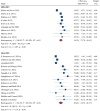Global prevalence of occupational injuries among sanitation workers: a systematic review and meta-analysis
- PMID: 39421826
- PMCID: PMC11483865
- DOI: 10.3389/fpubh.2024.1425904
Global prevalence of occupational injuries among sanitation workers: a systematic review and meta-analysis
Abstract
Background: In the sanitation sector, occupational injuries among sanitary workers (SWs) are prevalent due to hazardous working conditions and poor environmental surroundings. Despite the significant risks faced by these workers, the issue has received limited attention, and no comprehensive global meta-analysis on occupational injuries among sanitary workers has been conducted to date.
Objective: In this study, we aimed to conduct a systematic review and meta-analysis of occupational injuries among sanitary workers globally from 2000 to 2023.
Methods: The Preferred Reporting Items for Systematic Reviews and Meta-Analysis (PRISMA) guidelines were followed for the screening process, and the Population, Intervention, Comparison, Outcome and Study (PICOS) framework was to formulate search questions. Published articles from 2000 to 2023 were retrieved using various search engines. The keywords used were as follows: "Occupation Job Injuries" *OR "Work Injuries" *OR "Occupational Injuries" AND "Sanitary workers" ("Street sweepers" [SS] *OR "health facilities cleaners" [HCFC]) *OR "Solid waste collectors" [SWCs] *OR "Sewage workers" [STW] were used. Data analysis was performed using Stata Version 17MP. The overall effect size was calculated using the random-effects model combined with the restricted maximum likelihood (REML) approach, known as the Random-Effect REML Model. A 95% confidence interval (CI: 95%) was applied, and a p-value of less than 0.05 was considered statistically significant.
Results: Studies were sourced from PubMed (n = 34), Medline (n = 39), Embase (n = 23), Global Health (n = 37), other databases (n = 54), and review studies (n = 10), resulting in a total of 197 studies. Of these, only 23 studies fully met the inclusion criteria. Among 8,138 sanitary workers (SWs), 4,469 (55%) were solid waste collectors (SWCs), 2,317 (28%) were street sweepers (SS), 1,144 (14%) were health facility cleaners (HCFC), and 208 (3%) were a combination of SS and SWCs. Globally, the pooled prevalence of occupational injuries among SWs was 36.49% (95%CI: 0.29-0.45). Specifically, 39.14% (95%CI: 0.24-0.53) prevalence was observed in high-income countries, while 35.22% (95%CI: 0.36-0.44) was reported in low-income countries. Year-by-year analysis showed a prevalence of 36.70% (95%CI:0.28-0.46) from 2001 to 2015 and 36.45% (95% CI:0.25-0.48) from 2016 to 2022. The overall heterogeneity of the studies was substantial, with an I-squared value of 90.03% and a heterogeneity index of 214.43 (p < 0.05), indicating statistically significant heterogeneity among the eligible studies.
Conclusion: This systematic review and meta-analysis revealed that sanitation and hygiene workers face an increased risk of occupational injuries, largely due to insufficient attention to occupational safety and health services in their work environments. To mitigate these risks, the review recommends policy amendments, national regulations, and international initiatives aimed at improving occupational health and safety (OHS) services for these workers. These measures are crucial for reducing the prevalence of work-related injuries in the sanitation sector.
Keywords: burden; global; injuries; occupation; sanitary workers.
Copyright © 2024 Tolera, Gobena, Assefa and Geremew.
Conflict of interest statement
The authors declare that the research was conducted in the absence of any commercial or financial relationships that could be construed as a potential conflict of interest.
Figures






Similar articles
-
Sero-prevalence of hepatitis viral infections among sanitary workers across worldwide: a systematic review and meta-analysis.BMC Infect Dis. 2023 Jun 13;23(1):404. doi: 10.1186/s12879-023-08354-1. BMC Infect Dis. 2023. PMID: 37312028 Free PMC article.
-
Occupation-related respiratory diseases among sanitary workers in the workplace: a systematic review and meta-analysis.Front Public Health. 2024 Nov 26;12:1501768. doi: 10.3389/fpubh.2024.1501768. eCollection 2024. Front Public Health. 2024. PMID: 39659714 Free PMC article.
-
Global systematic review of occupational health and safety outcomes among sanitation and hygiene workers.Front Public Health. 2023 Dec 19;11:1304977. doi: 10.3389/fpubh.2023.1304977. eCollection 2023. Front Public Health. 2023. PMID: 38174086 Free PMC article.
-
Global prevalence of musculoskeletal disorders among sanitary workers: a systematic review and meta-analysis.Int J Occup Saf Ergon. 2024 Mar;30(1):238-251. doi: 10.1080/10803548.2023.2293390. Epub 2024 Jan 1. Int J Occup Saf Ergon. 2024. PMID: 38083826
-
Occupational injuries and associated factors among sanitary workers in public hospitals, eastern Ethiopia: A modified Poisson regression model analysis.PLoS One. 2024 Nov 15;19(11):e0310970. doi: 10.1371/journal.pone.0310970. eCollection 2024. PLoS One. 2024. PMID: 39546541 Free PMC article.
Cited by
-
Co-occurrence of occupational outcomes and associated factors among hospitals cleaners, eastern ethiopia: a cross sectional study.BMC Public Health. 2024 Nov 11;24(1):3108. doi: 10.1186/s12889-024-20571-0. BMC Public Health. 2024. PMID: 39529077 Free PMC article.
References
-
- World Health Organization . Health, safety and dignity of sanitation workers: an initial assessment. Guidelines on sanitation and health. Geneva: World Health Organization; (2018).
-
- Kabir A, Farhana N, Akter F, Jesmin S, Ali A. Sweeping practices, knowledge about OSH hazards in Dhaka city, Bangladesh: a qualitative inquiry. Int J Commun Med Pub Health. (2015) 2:237–43. doi: 10.18203/2394-6040.ijcmph20150476 - DOI
-
- World Health Organization . New report exposes horror of working conditions for millions of sanitation workers in the developing world WHO; (2019) Available at: https://www.who.int/news/item/14-11-2019.
Publication types
MeSH terms
LinkOut - more resources
Full Text Sources
Medical
Miscellaneous

